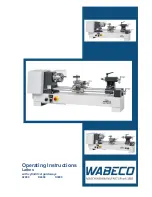
OPERATION
MOUNTING ON THE FACE PLATE
Use of the face plate is the most common for holding a block of wood for turning bowls and plates.
This is an alternative option for workpieces with diameters that are greater than the 12-inch throat of
the lathe.
To mount the stock to the face plate, select a stock that is at least .2 inches (5 mm) larger than each
dimension of the finished workpiece. Always select the largest diameter face plate that can be used
for the workpiece at hand.
Fig. 25
SANDING
- Leaving clean cuts will reduce the amount of sanding required. Move the tool rest out of
the way, adjusting the lathe to a low speed. Being with find sandpaper (120 grit or finer), as coarser
sandpaper will leave deep scratches and dull the features of the workpiece. Progress through each
grit without skipping grits (as in, don’t jump from 120 grit to 220 grit). Fold the sandpaper into a pad;
do not wrap sandpaper around your fingers or the workpiece.
FINISHING
- To apply a finish, the workpiece can be left on the lathe. Turn off the lathe and use a
brush or paper towel to apply the finish. Remove excess finish before restarting the lathe. Only start
it at a very low speed with awareness that fresh coats have a tendency to splash and fling if not given
adequate drying time. Allow it to dry and sand again with 320 to 400 grit sandpaper. Apply a second
coat of finish and buff.
True one of the surfaces of the workpiece for
mounting against the faceplate. Using the face
plate as a template, mark the location of the
mounting holes on the workpiece and drill pilot
holes of the appropriate size.
If the mounting screws on the face plate interfere
with the workpiece, a glue or waste block can be
used (Fig. 25). Make sure the block is of the same
diameter as the face plate. Both the waste block
and the workpiece should have flat surfaces for
gluing. Glue the block to the workpiece. Avoid
using brown paper or newspaper between the
waste block and workpiece. It may work fine if you
are using scrapers, but a slight catch with a bowl
gouge can separate the two.
While face plates are the simplest, most reliable
method of holding a larger block of wood for
turning, chucks can also be used. A chuck is not a
requirement, but is handy when working on more
than one piece at a time. Rather than removing
screws, you simply open the chuck and change
workpieces. The most popular ones are four jaw
scroll chucks (dovetails) with a variety of jaws
to accommodate different size tenons. Most also
come with a screw chuck as well.
Fig. 24
19
Summary of Contents for 34027
Page 23: ...EXPLODED VIEW PARTS LIST 23...

































